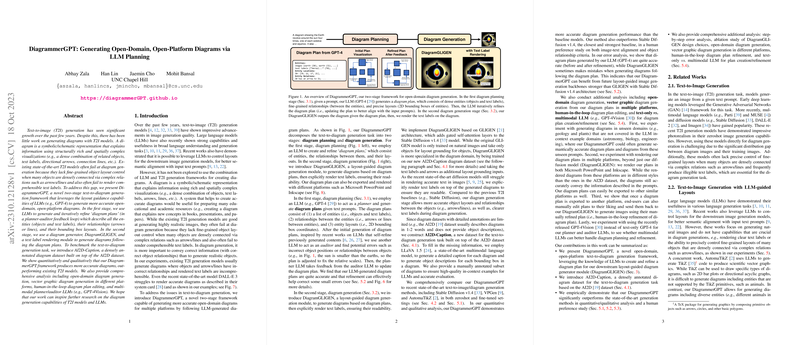Overview of DiagrammerGPT: Generating Open-Domain, Open-Platform Diagrams via LLM Planning
This paper introduces DiagrammerGPT, a two-stage text-to-diagram generation framework specifically designed to bridge existing gaps in generating structurally complex and information-rich diagrams. Despite the progress in text-to-image (T2I) generation models, generating accurate diagrams remains a challenge due to the inability of these models to manage intricate object layouts and legible text labels. DiagrammerGPT addresses these limitations by utilizing LLMs for strategic planning, followed by a dedicated diagram generation phase.
Key Contributions
The authors present a comprehensive framework divided into two distinct stages: diagram planning and diagram generation.
- Diagram Planning: The initial phase involves generating a precise layout plan using a planner LLM such as GPT-4. This plan details all diagram entities, their interconnections, and their spatial arrangements. This process incorporates a planner-auditor feedback loop, where the LLM iteratively refines the diagram plan based on feedback to correct errors and enhance alignment with input prompts.
- Diagram Generation: In the subsequent phase, the framework employs DiagramGLIGEN, a specialized diagram generation module. This module is accompanied by a text label rendering system to ensure the clarity and accuracy of the final output.
The framework’s efficacy is benchmarked using AI2D-Caption, a richly annotated dataset derived from the AI2D dataset. This dataset specifically caters to the requirements of the text-to-diagram task, providing a strong basis for both training and evaluation.
Empirical Validation
DiagrammerGPT demonstrates superior performance over existing T2I models by producing more accurate diagrammatic representations. Through both qualitative and quantitative assessments, the authors show the framework’s effectiveness in handling open-domain diagram tasks and generating vector graphics suitable for various platforms, such as Microsoft PowerPoint and Inkscape.
Implications and Future Directions
The research presents several notable implications:
- Advancements in Educational Tools: Accurate diagram generation has significant potential in educational and academic settings, where diagrams serve as essential tools for visual learning and information dissemination.
- Document Preparation Efficiency: The ability to generate and edit diagrams across different platforms improves efficiency in the preparation of presentations and publications.
- Human-in-the-loop Design: The paper also explores interactive design features that allow end-users to refine and modify diagram plans, providing flexibility and customization in diagram creation.
While DiagrammerGPT exemplifies a robust and versatile approach to diagram generation, it also opens pathways for future research. The development of stronger layout-guided image generation models could further enhance the precision and quality of generated diagrams. Furthermore, optimizing LLMs for diagrammatic tasks and exploring their utility in different languages and contexts could significantly broaden the framework’s applicability.
Conclusion
DiagrammerGPT represents an innovative stride forward in diagram generation technology, adeptly combining the strengths of LLMs with targeted diagram generation techniques to overcome prevalent limitations in traditional T2I methods. Its success, validated by empirical data and benchmark comparisons, underscores its capability to inspire continued advancement in automated diagram generation and its applications, fostering a more integrated and efficient model for knowledge representation.
